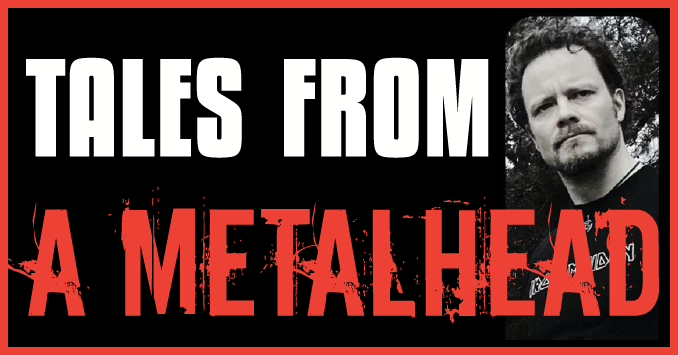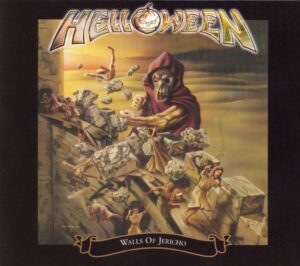
This chapter is part of a book called Tales from a Metalhead written by Metal Express Radio’s President Stig G. Nordahl. The chapters will be posted one at the time and you can find them all here.
 Overture! Many Hard Rock and Metal bands adopted the term from Classical music. However, over the years it’s become more typical for Hard Rock and Metal than any other genre I think. A fancy word, right? It unquestionably adds a touch of sophistication and mystique that goes beyond the simple “intro.” I learned that back in the day an overture usually gave some hints of what was to come later by including elements from the opera itself. The definition faded along the way. It’s just cooler to call the passage an “overture” rather than “intro”, and it has been for a long time. Just ask Rush, Def Leppard or W.A.S.P. who all had their respective overtures. Dream Theater are also fans of overtures. Of course, they are a Progressive Metal band, so that’s like calling water wet. Their overture on Six Degrees of Inner Turbulence contains elements from single sections of that album, foreshadowing what’s to come. That actually fits well with the 18th-century practice for an overture.
Overture! Many Hard Rock and Metal bands adopted the term from Classical music. However, over the years it’s become more typical for Hard Rock and Metal than any other genre I think. A fancy word, right? It unquestionably adds a touch of sophistication and mystique that goes beyond the simple “intro.” I learned that back in the day an overture usually gave some hints of what was to come later by including elements from the opera itself. The definition faded along the way. It’s just cooler to call the passage an “overture” rather than “intro”, and it has been for a long time. Just ask Rush, Def Leppard or W.A.S.P. who all had their respective overtures. Dream Theater are also fans of overtures. Of course, they are a Progressive Metal band, so that’s like calling water wet. Their overture on Six Degrees of Inner Turbulence contains elements from single sections of that album, foreshadowing what’s to come. That actually fits well with the 18th-century practice for an overture.
In general, I am not a big fan of overtures, but if I were challenged to mention a band that has been successful in adding these little instrumental cuts I’d say Symphony X. Guitar slinger and songwriter Michael Romeo is a brilliant composer, not only when it comes to Progressive Metal, but also these pompous Classical pieces. Symphony X has of course their overture and prelude as well, but got a bit more creative after that with titles in Latin, like “Oculus Ex Inferni.” The funny thing is that when Romeo released his solo albums War of the Worlds pt 1 and pt 2, he composed some mesmerizing opening Classical compositions, named simply “Introduction” (pt 1 and 2).
 Speaking of preludes, let’s not forget those! I bet you know the one on Judas Priest’s Sad Wings of Destiny album. The definition of a prelude “[…] is a piece of music that traditionally leads into something else”. Priest’s 2:01 long cut leads into the brilliant “Tyrant” of course. I think they are home free when it comes to following the definition. It seems like a Metal track containing the word “prelude” is more of a lyrical thing than anything else, meaning they are full tracks, like Fates Warning’s “Prelude To Ruin”. Savatage’s instrumental “Prelude To Madness” also comes to mind. It serves as the introductory track before the title track on the brilliant album Hall of the Mountain King. It’s a delightful nod to the Norwegian classical composer Edvard Grieg’s more famous composition with the same name. You can’t help but wonder if Grieg’s original piece would have sounded like Savatage’s version if he had access to distorted guitars back in the day. Some even speculate that Johann Sebastian Bach might have been a metalhead had he grown up in a later era, so why not Grieg? As Bach was deeply religious he would probably have been a member of Stryper. Since Savatage already used “Prelude to Madness”, the band Axemaster had to be creative and call their album Overtures to Madness. Better than “intros to madness” anyway, isn’t it?
Speaking of preludes, let’s not forget those! I bet you know the one on Judas Priest’s Sad Wings of Destiny album. The definition of a prelude “[…] is a piece of music that traditionally leads into something else”. Priest’s 2:01 long cut leads into the brilliant “Tyrant” of course. I think they are home free when it comes to following the definition. It seems like a Metal track containing the word “prelude” is more of a lyrical thing than anything else, meaning they are full tracks, like Fates Warning’s “Prelude To Ruin”. Savatage’s instrumental “Prelude To Madness” also comes to mind. It serves as the introductory track before the title track on the brilliant album Hall of the Mountain King. It’s a delightful nod to the Norwegian classical composer Edvard Grieg’s more famous composition with the same name. You can’t help but wonder if Grieg’s original piece would have sounded like Savatage’s version if he had access to distorted guitars back in the day. Some even speculate that Johann Sebastian Bach might have been a metalhead had he grown up in a later era, so why not Grieg? As Bach was deeply religious he would probably have been a member of Stryper. Since Savatage already used “Prelude to Madness”, the band Axemaster had to be creative and call their album Overtures to Madness. Better than “intros to madness” anyway, isn’t it?
 There are interludes as well, of course. Numerous albums have short cuts lasting just a minute or two. Not necessarily called an interlude though. They are especially typical for conceptual albums. For musical pieces it usually works well, but when it comes to spoken parts … I mean, you can listen to a good track a thousand times, but do you really want to hear a spoken part over and over? The band Sculforge just released a rather good album called Intergalactic Battle Tunes containing close to 30 tracks! But just half of it is music, the rest is spoken parts between the songs. That makes me not want to listen to the album, which is too bad really. Another annoying example is Manowar’s “The Warrior’s Prayer” from the brilliant Kings of Metal album. It was cool to hear grandfather spend 4:20 telling the story about the Metal Kings to his grandson the first time, but come on! I always skip that track. Queensrÿche balanced this in a delicate way on Operation: Mindcrime. Learn from the masters! I’ll get back to that album very soon.
There are interludes as well, of course. Numerous albums have short cuts lasting just a minute or two. Not necessarily called an interlude though. They are especially typical for conceptual albums. For musical pieces it usually works well, but when it comes to spoken parts … I mean, you can listen to a good track a thousand times, but do you really want to hear a spoken part over and over? The band Sculforge just released a rather good album called Intergalactic Battle Tunes containing close to 30 tracks! But just half of it is music, the rest is spoken parts between the songs. That makes me not want to listen to the album, which is too bad really. Another annoying example is Manowar’s “The Warrior’s Prayer” from the brilliant Kings of Metal album. It was cool to hear grandfather spend 4:20 telling the story about the Metal Kings to his grandson the first time, but come on! I always skip that track. Queensrÿche balanced this in a delicate way on Operation: Mindcrime. Learn from the masters! I’ll get back to that album very soon.
The world of Metal has witnessed numerous tracks receiving the special treatment of an attached intro. Few things are as electrifying as Accept’s intro to “Fast as a Shark,” setting the stage for their album Restless and Wild. It transitions from a crackly old children’s recording of a traditional German tune titled “Ein Heller und ein Batzen” into what’s arguably the genesis of Speed Metal. The band thought it would be hilarious to juxtapose this innocent children’s tune with their heavy metal sound. And to top it off, a young Dieter Dierks, who owned the studio where the album was recorded, was actually singing on the recording. Talk about an inside joke that became a legendary intro. Halloween echoed this approach on their debut EP. The album opens with a rather lengthy introduction featuring a guy waking up, opening a beer, burping, and presumably scratching his behind as he tries to find something cool on the radio. That “Happy Happy Halloween” track, which sounds like a choir that just inhaled helium, catches his attention (the song is actually borrowed from the 1982 film Halloween III). This intro goes on for more than a minute before Kai Hansen breaks the silence with a gut-wrenching scream that kicks off “Starlight,” much like Udo Dirkschneider does in “Fast as a Shark.”
 Judas Priest would open the Ram It Down album the same screeeaaaaming way a bit longer down the road, but they skipped the intro of course. Bang on instead! No intro needed. On their first full-length album Helloween would further explore the Halloween theme, but drenched in a more pompous, orchestral manner, definitely without the helium-infused vocals. The track is essentially the same, yet Helloween christened the intro as “Wall of Jericho,” making it the album‘s title track which leads into the fabulous and speedy “Ride the Sky”. Both bands, Accept and Helloween, have masterminded a variety of classic intros, such as Accept’s “Metal Heart” and Helloween’s “Initiation” and “Invitation,” serving as standalone tracks on Keeper of the Seven Keys pt 1 and pt 2. The intro part for “Metal Heart” is of course taken from Tchaikovsky’s “Slavonic March.” For some reason I thought that was Accept’s own composition. I probably didn’t read the liner notes thoroughly when the album was released. Years later when I bought a Best of Tchaikovsky CD I recognized the composition. It was a given that Tchaikovsky, who died in 1893, didn’t steal it from Accept so… They are definitely not the only Metal band to use classical parts for intros. Pretty Maids has “Fortuna Imperatrix Mundi” by Carl Orff to kick off their debut album Red Hot and Heavy, probably better known as Ozzy Osbourne’s opening track in his live shows back in the day, as you can hear on the Tribute live album. Trans-Siberian Orchestra couldn’t let that fabulous piece of Classical music go either. Check out the Nightcastle album (if you are into Christmas-ish music…).
Judas Priest would open the Ram It Down album the same screeeaaaaming way a bit longer down the road, but they skipped the intro of course. Bang on instead! No intro needed. On their first full-length album Helloween would further explore the Halloween theme, but drenched in a more pompous, orchestral manner, definitely without the helium-infused vocals. The track is essentially the same, yet Helloween christened the intro as “Wall of Jericho,” making it the album‘s title track which leads into the fabulous and speedy “Ride the Sky”. Both bands, Accept and Helloween, have masterminded a variety of classic intros, such as Accept’s “Metal Heart” and Helloween’s “Initiation” and “Invitation,” serving as standalone tracks on Keeper of the Seven Keys pt 1 and pt 2. The intro part for “Metal Heart” is of course taken from Tchaikovsky’s “Slavonic March.” For some reason I thought that was Accept’s own composition. I probably didn’t read the liner notes thoroughly when the album was released. Years later when I bought a Best of Tchaikovsky CD I recognized the composition. It was a given that Tchaikovsky, who died in 1893, didn’t steal it from Accept so… They are definitely not the only Metal band to use classical parts for intros. Pretty Maids has “Fortuna Imperatrix Mundi” by Carl Orff to kick off their debut album Red Hot and Heavy, probably better known as Ozzy Osbourne’s opening track in his live shows back in the day, as you can hear on the Tribute live album. Trans-Siberian Orchestra couldn’t let that fabulous piece of Classical music go either. Check out the Nightcastle album (if you are into Christmas-ish music…).
 Speaking of lengthy intros, let’s not overlook Kiss’ “Detroit Rock City.” Well, maybe not longer than average, it just feels like it. The track seemingly unfolds a narrative, yet the song would have erupted as a thunderous opener on Destroyer without the one-and-a-half-minute preamble of sound effects. Nonetheless, if you grew up with the intro, its absence might be sorely missed. Intros, regardless of their elaboration or peculiarity, often become an integral part of the songs and the albums they introduce. I’d skip this one myself if it was a standalone track and I played it back from a CD player.
Speaking of lengthy intros, let’s not overlook Kiss’ “Detroit Rock City.” Well, maybe not longer than average, it just feels like it. The track seemingly unfolds a narrative, yet the song would have erupted as a thunderous opener on Destroyer without the one-and-a-half-minute preamble of sound effects. Nonetheless, if you grew up with the intro, its absence might be sorely missed. Intros, regardless of their elaboration or peculiarity, often become an integral part of the songs and the albums they introduce. I’d skip this one myself if it was a standalone track and I played it back from a CD player.
Naming a song or intro must be as difficult as giving a title to an ordinary instrumental track, especially if you just don’t want to go with “Overture” or “Prelude.” Should the title reflect the opening track or the concept on the album, if there is such a thing? Vicious Rumors’ album Digital Dictator kicks off with “Replicant.” The guys had obviously read or seen Blade Runner, but the title here walks hand in hand with the title track, “Digital Dictator,” which is the first regular song. On the LP version, the intro goes directly into the main track, connected with a thunderous drum break. When the CD format came along, it disrupted this seamless transition from intro to track because there was silence in-between, as long as they are two separate tracks. Even though the album is called Digital Dictator, they probably didn’t anticipate that digital formats would disrupt this. Live albums were often ruined the same way when they were released on CD. I always hated those gaps.
 To some bands, intros have become just as an important part of their live shows as their biggest classic songs. Could you imagine Metallica entering the stage without “The Ecstasy Of Gold” from the film The Good, The Bad and the Ugly being played first? Intros frequently serve as an integral part of live performances. Their delivery from the stage before the band emerges creates a palpable tension and excitement, with crowds often joining in if there are spoken lyrics. “We shall fight with growing confidence and growing strength in the air, we shall defend our island, whatever the cost may be…”. Yeah, you may know that one well. My father would probably recognize this as well even though he probably cannot name one Iron Maiden track. The band opened their shows on the World Slavery Tour with Churchill’s historic speech before launching into “Aces High”. A magical experience indeed, even on VHS or vinyl back then. The band never visited my turf on that tour, which seemed to include all other countries in the world. Equally iconic is, of course, the opening line of “Number of the Beast,” where the crowd engages in a call-and-response ritual. Maiden does, of course, have several more, like “The Prisoner” and “Powerslave.”
To some bands, intros have become just as an important part of their live shows as their biggest classic songs. Could you imagine Metallica entering the stage without “The Ecstasy Of Gold” from the film The Good, The Bad and the Ugly being played first? Intros frequently serve as an integral part of live performances. Their delivery from the stage before the band emerges creates a palpable tension and excitement, with crowds often joining in if there are spoken lyrics. “We shall fight with growing confidence and growing strength in the air, we shall defend our island, whatever the cost may be…”. Yeah, you may know that one well. My father would probably recognize this as well even though he probably cannot name one Iron Maiden track. The band opened their shows on the World Slavery Tour with Churchill’s historic speech before launching into “Aces High”. A magical experience indeed, even on VHS or vinyl back then. The band never visited my turf on that tour, which seemed to include all other countries in the world. Equally iconic is, of course, the opening line of “Number of the Beast,” where the crowd engages in a call-and-response ritual. Maiden does, of course, have several more, like “The Prisoner” and “Powerslave.”
Other bands have opted for a straightforward approach on live shows that became a classic, like Kiss, announcing, “You wanted the best, you got the best, the hottest band in the world… KISS!” Iconic! Or the even more concise, “We are Motörhead, and we play Rock ‘n’ Roll.” Krokus has their version welcoming themselves as “The Kings of Rock.” I love Krokus, but they never lived up to that title.
I believe a stand-alone track that opens the album is what we can call an album intro. The following track is definitely not placed there by chance. Obviously, bands put a lot of effort into setting the track order right, but the first track normally stands out. When in the process does a band decide to make an intro? After deciding on the opening track? I don’t know. It’s clear that intros are designed to generate tension or seize attention, usually standing independently without musical connection to the subsequent track. Does it have to be a stand-alone track to be an album intro? Shall it be regarded as just a song intro if it is spliced with the first song, even though the song opens the album? Does it matter? Guess not.
Sound effects have often been included in intros. Back in the day, production studios had stock collections of effects they could use on records if they were too lazy to record any themselves. Sometimes the same effects were used on different albums. The intro track “T.n.T. (Terror ‘n Tinseltown)” from Mötley Crüe’s Dr. Feelgood release features a sample of a woman saying “Dr. Davis, telephone please.” This was the same sample used by Queensrÿche for their song “Eyes of a Stranger,” on Operation: Mindcrime released one year prior to Dr. Feelgood. The film studios had their stock effects too. To this day, you can still hear the famous “The Wilhelm Scream”, which became a hit among movie producers after being used in many films for years.
Some bands go through the effort of recording the effects themselves. For example, Max Cavalera recorded and used the heartbeat of his then-unborn first son, Zyon, in the short intro for Sepultura’s “Refuse / Resist.” Meanwhile, the Norwegian band Artch spent a night in a hospital to capture the sound of a crying newborn baby for their “Conversio Prelude” which opens their debut album. Fun fact: In the ‘80s I was an eager magician, and I actually used that very intro for one of the tricks I performed in my stage act. It sounds dramatic, and the length was a perfect levitation effect. I also used Van Halen’s “1984” for the same purpose at one point. I never totally got what that intro is all about really. Eddie Van Halen showing off his new Oberheim synth? He certainly got the chance to do that in the opener “Jump” anyway. It worked well for magic though. Yeah, always play some Metal related stuff when you can, right?
“Overture” and “Prelude” are, of course, band names too! Shouldn’t be a surprise that they belong to the Progressive side of Hard Rock. I don’t know if there is any Metal band called “Intro” (which obviously would be a rather dull name for a band). The closest we get would be Nitro, ha ha.
Y&T, however, challenged this norm with their album Black Tiger. Their guitar based intro, “From the Moon,” reemerges as the commencement of “Forever” later on the album. A more punchy version with drums that is. It’s an intriguing twist that leaves one wondering which piece came first; the intro or the song. Such mysteries often remain unresolved, even by the artists themselves. At least Dave Meniketti couldn’t remember when I asked him about it. Oh dear, what a nerdy question to ask!
In the realm of conceptual albums, intros are not just expected, they are imperative. They set the stage for the narrative to unfold, as in Operation: Mindcrime, where we eagerly anticipate Nicky’s next shot from the nurse. Similarly, Them welcomes us back into King Diamond’s eerie narrative with grandma returning in the opening “Out From the Asylum”. The latter followed by Mickey Dee’s legendary drum break on “Welcome Home”.
Initially, I had different plans sitting down to write this chapter. However this week, Judas Priest released their first single, “Panic Attack” from their upcoming album. The track got mixed reactions among the Metal Express Radio crew. Because of the … intro! Some found it too long, while others disliked the use of reverb that distinguishes the rest of the track. Perhaps, if labeled as a prelude when the album comes out, it would be better received? No wait, they already have a prelude. They must go for an overture! Anyway, it’s hard to come up with something more classic than “The Hellion” that opens the Screaming For Vengeance album..
Our little debate about the very first minute of that song made me think about intros in general. You just got my take on the overtures!
It costs a lot to keep Metal Express Radio running. Let’s face it, we’re a grassroots web radio and we do this because we love Metal. Any contributions that helps keeping us afloat are highly welcomed. We gladly accept donations on our donate page.




Be the first to comment